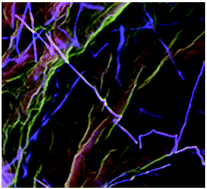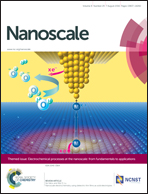Electroactive biomimetic collagen-silver nanowire composite scaffolds†
Abstract
Electroactive biomaterials are widely explored as bioelectrodes and as scaffolds for neural and cardiac regeneration. Most electrodes and conductive scaffolds for tissue regeneration are based on synthetic materials that have limited biocompatibility and often display large discrepancies in mechanical properties with the surrounding tissue causing problems during tissue integration and regeneration. This work shows the development of a biomimetic nanocomposite material prepared from self-assembled collagen fibrils and silver nanowires (AgNW). Despite consisting of mostly type I collagen fibrils, the homogeneously embedded AgNWs provide these materials with a charge storage capacity of about 2.3 mC cm−2 and a charge injection capacity of 0.3 mC cm−2, which is on par with bioelectrodes used in the clinic. The mechanical properties of the materials are similar to soft tissues with a dynamic elastic modulus within the lower kPa range. The nanocomposites also support proliferation of embryonic cardiomyocytes while inhibiting the growth of both Gram-negative Escherichia coli and Gram-positive Staphylococcus epidermidis. The developed collagen/AgNW composites thus represent a highly attractive bioelectrode and scaffold material for a wide range of biomedical applications.


 Please wait while we load your content...
Please wait while we load your content...